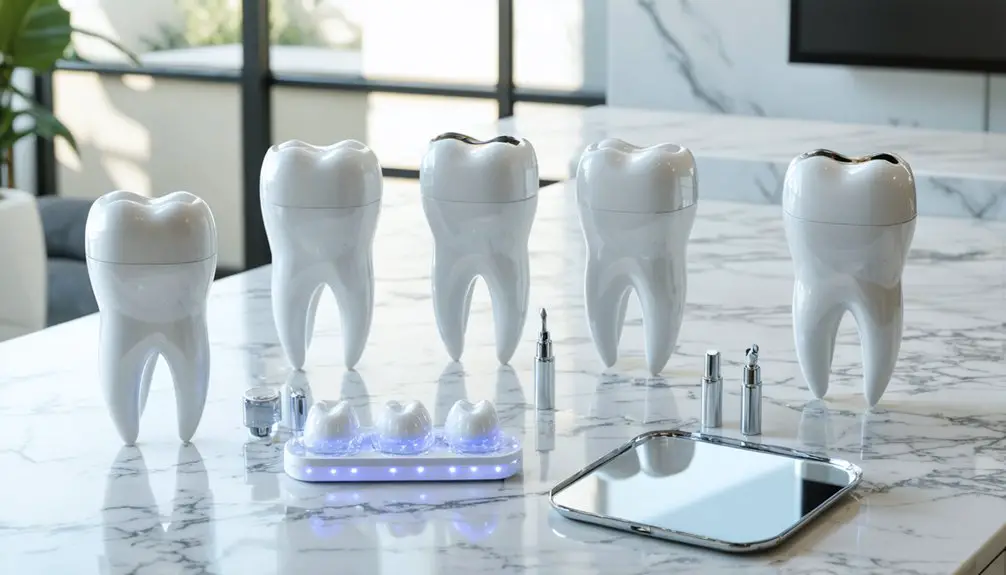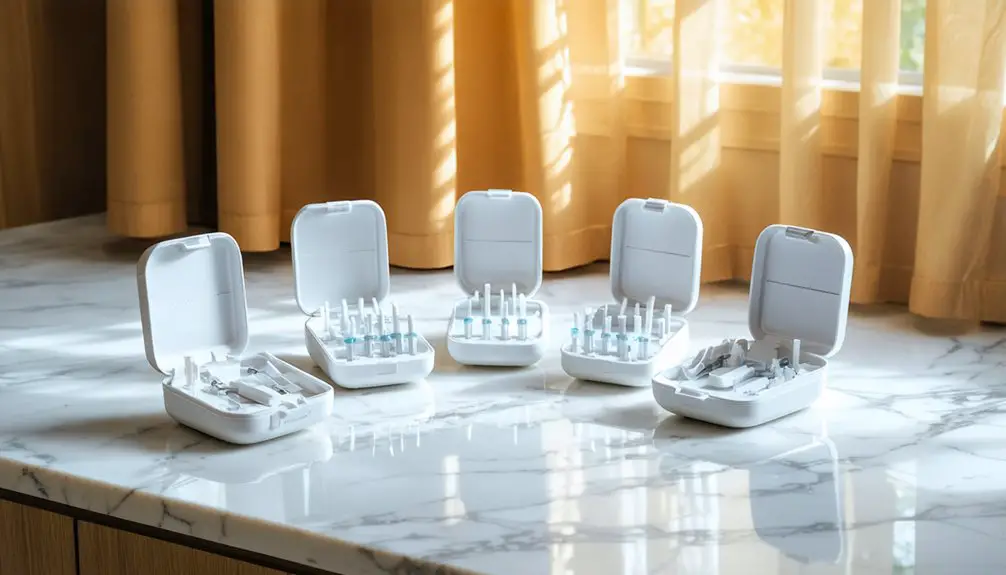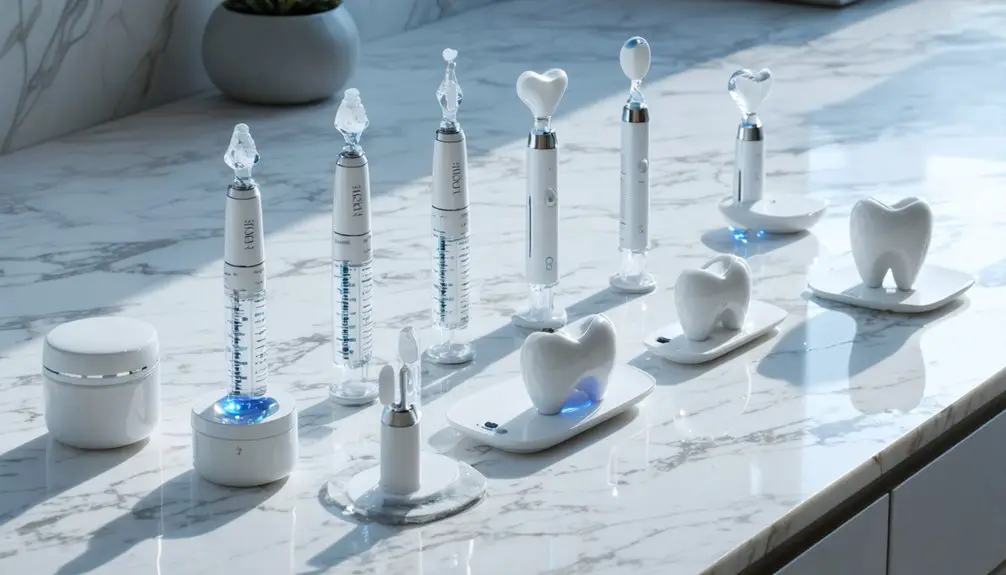You’ll find ideal results with professional-grade at-home whitening kits that use either custom-fitted trays or LED-assisted devices with hydrogen peroxide or carbamide peroxide formulations. For lasting effects, look for kits offering 10-30 minute treatment sessions over 2-3 weeks, with peroxide concentrations between 10-22%. While strips can lighten teeth by 2.6 shades, custom trays and LED systems deliver superior results. Understanding proper application techniques and safety guidelines will maximize your whitening success.
Key Takeaways
- Custom-fitted tray systems offer professional-grade results with precise gel application and comfortable long-term wear for consistent whitening.
- LED-accelerated whitening kits combine peroxide gels with light technology to speed up the whitening process without increasing sensitivity.
- Teeth whitening strips provide convenient, effective treatment for up to 2.6 shades lighter with one-hour daily applications.
- Professional at-home kits with custom trays balance optimal results and safety through dental supervision and higher-concentration peroxide gels.
- Boil-and-bite tray systems deliver affordable whitening with moldable trays that conform to your teeth for better coverage.
Understanding Home Teeth Whitening Technology
While teeth whitening has become increasingly accessible through home-based solutions, understanding the underlying technology is essential for achieving ideal results.
The primary whitening agents, hydrogen peroxide and carbamide peroxide, work by penetrating your tooth structure to break down stains through oxidation. These agents chemically alter both surface and deep stains within your enamel and dentin. Professional supervision is essential since higher concentrations of whitening gels deliver more dramatic results. Most treatments require only ten to thirty minutes per session for optimal effectiveness.
Many home kits incorporate light activation technology using LED or UV sources to accelerate the whitening process. While some studies support light’s effectiveness in speeding up results, you’ll need to weigh this benefit against potentially increased tooth sensitivity.
The key to success lies in proper application through well-fitted trays or strips that keep the whitening gel in consistent contact with your teeth while protecting surrounding tissues.
Comparing Top Teeth Whitening Kit Features
Modern teeth whitening kits offer diverse features and approaches to achieving a brighter smile. You’ll find three primary kit types: strips, trays, and LED-assisted devices. Each delivery system provides distinct advantages regarding ingredient effectiveness and user convenience.
Strips containing hydrogen peroxide can whiten teeth up to 2.6 shades within 19 days, requiring about an hour of daily wear. The innovative Zimbas whitening strips achieved an impressive 2.7 shade improvement in just two weeks of use. Many dentists recommend getting a professional cleaning before starting any whitening treatment for optimal results.
Custom-fitted trays deliver professional-level results through prolonged contact with carbamide peroxide gels, while boil-and-bite options offer a more affordable alternative.
LED-assisted devices accelerate peroxide activation without increasing sensitivity.
When selecting a kit, you’ll need to balance effectiveness against cost. Higher-end options like custom trays provide superior results but command premium prices, while drugstore alternatives offer more modest improvements at accessible price points.
Safety and Sensitivity Considerations
Before starting any teeth whitening regimen, you’ll need to understand the potential risks and safety considerations to protect your oral health. Over-the-counter whitening products can cause gum irritation and enamel erosion if not used properly, especially with ill-fitting trays or excessive chemical concentrations. Natural remedies using ingredients like acidic solutions can permanently damage tooth enamel.
You shouldn’t use whitening kits if you have untreated cavities, gum disease, or dental work like crowns and veneers, as these won’t respond to bleaching agents. Pregnant women should also avoid using at-home whitening products as harsh chemicals could be harmful.
Temporary tooth sensitivity is common, so avoid hot and cold foods after treatment. To minimize risks, choose name-brand products with professional endorsements, follow instructions precisely, and consider getting custom-fitted trays from your dentist.
If you experience persistent gum irritation or severe sensitivity, discontinue use and consult your dental professional immediately.
Cost-Effectiveness and Value Analysis
Understanding the cost-effectiveness of teeth whitening options requires careful analysis of both upfront expenses and long-term value. While OTC kits range from $5 to $60, professional treatments can reach $1,000, making pricing strategies a vital factor in consumer preferences. Geographic location affects pricing significantly, as dental services in major metropolitan areas tend to cost more.
You’ll find that professional at-home kits ($100-$600) strike a balance between cost and results, offering custom-fitted trays and higher-concentration peroxide gels. Though more expensive initially, these kits provide more uniform whitening and typically last 4-6 months. Consulting with experienced dentists ensures proper application techniques and optimal results for your specific needs.
In contrast, OTC products may require more frequent applications due to lower peroxide concentrations, potentially increasing long-term costs.
When evaluating value, consider that professional oversight reduces sensitivity risks and guarantees proper application, while in-office treatments, though costly, can maintain results for up to three years.
Best Practices for Long-Term Whitening Success
Maintaining your whitening results requires a thorough approach that combines proper oral hygiene, dietary modifications, and strategic lifestyle choices.
For ideal whitening maintenance, brush twice daily with fluoride toothpaste and floss regularly to prevent stain-causing plaque buildup. Replace your toothbrush every three months to guarantee effective cleaning. Regular dental appointments with professional cleanings will help maintain your bright smile. Smoking cessation is essential for preventing tooth discoloration.
Make essential dietary adjustments by limiting coffee, tea, and red wine consumption. When you do consume staining beverages, use a straw and rinse immediately afterward.
Minimize staining by reducing dark beverages and using a straw. When indulging, rinse your mouth promptly to protect your bright smile.
Include crunchy fruits and vegetables in your diet to naturally clean teeth. Schedule regular dental check-ups for professional cleanings, and consider periodic touch-up treatments to maintain your desired shade.
During the critical 48 hours post-whitening, be particularly vigilant about avoiding staining substances while your enamel is most vulnerable.
Frequently Asked Questions
Can I Use Teeth Whitening Kits While Pregnant or Breastfeeding?
Like a protective mother bear, you shouldn’t use whitening kits during pregnancy or breastfeeding due to safety concerns. Focus on gentle brushing and natural alternative options until after these precious periods end.
How Soon After Dental Work Can I Start Using Whitening Products?
You’ll need to wait 7-14 days after fillings and two weeks after most dental work, considering post treatment timing and dental sensitivity concerns. Always consult your dentist for specific guidance.
Will Whitening Treatments Work on Dental Crowns or Veneers?
Like rain beading off a glass window, whitening agents can’t penetrate your dental crowns or veneers. The non-porous dental material maintains its original shade regardless of any whitening treatments you apply.
Can Teenagers Safely Use Home Teeth Whitening Kits?
You shouldn’t use home whitening kits if you’re under 15-18, due to safety guidelines and age restrictions. Wait until your teeth are fully developed and consult a dentist for professional guidance.
Should I Whiten My Teeth Before or After Getting Braces Removed?
Like peeling an orange before it’s ripe, whitening timing is essential. You’ll need to wait at least six months after braces removal to guarantee proper braces care and achieve uniform, lasting whitening results.
References
- https://www.tribecasmiles.com/best-home-teeth-whitening-products-2025
- https://www.goodhousekeeping.com/health-products/g28723133/best-at-home-teeth-whitening-products/
- https://www.youtube.com/watch?v=aHosC0H-JDk
- https://nhdentistrybeverlyhills.com/press/6-of-the-best-teeth-whitening-kits-in-the-drugstore/
- https://www.cnet.com/health/personal-care/best-teeth-whitening-kits/
- https://www.trysnow.com/blogs/news/how-do-teeth-whitening-machines-work
- https://pmc.ncbi.nlm.nih.gov/articles/PMC3466022/
- https://www.colgate.com.au/oral-health/teeth-whitening/how-does-led-teeth-whitening-work
- https://www.youtube.com/watch?v=9iCUMh7gRRQ
- https://pmc.ncbi.nlm.nih.gov/articles/PMC4058574/



